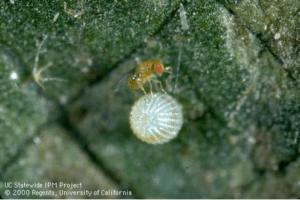Trichogramma pretiosum
One of the most widely known, utilized, and researched beneficial insects in the world is Trichogramma pretiosum, a minute wasp averaging under 0.5mm. Belonging to the Trichogrammatidae family, with over 230 known species worldwide, Trichogramma pretiosum has been widely exploited for biological and integrated control of crop pests.
A more generalized parasitoid then several other Trichogramma species, Trichogramma pretiosum is able to parasitize a range of different species including Lepidopteran (moth and butterfly) pest insects, including cabbage moth (diamondback moth), carob moth, corn ear worm, tomato fruitworm, cotton bollworm; loopers; heliothis (Helicoverpa armigera and H. punctigera), and others in field crops, vineyards and stored grain.
How it works
An egg parasitoid, the adult female lays her eggs into mother eggs. As the wasp eggs hatch, the larvae devour the developing caterpillar inside the moth egg. The larvae then pupate and grow into fully formed wasps inside the moth eggs. Wasps emerge by chewing a hole in the moth egg and are then ready to parasitize other moth eggs, a process that takes from seven to ten days, depending on temperature. A female wasp can parasitize over fifty moth eggs during her lifespan of up to 2 weeks. Mated female wasps will produce both male and female offspring. Unmated females can parasitise eggs but will produce only male offspring.
Identification

Source: https://bugsforbugs.com.au/product/trichogramma/

Source: https://ipm.ucanr.edu/PMG/H/I-LP-HZEA-TS.028.html
Trichogramma are difficult to reliably identify to species due to their minute size and similar appearance. The adults are generally orange to yellowish brown and 1/100 to 1/25 inch (0.25–1 mm) long. The antennae are relatively short. The bulging eyes and tiny, dotlike light receptors on top the head (ocelli) are red.
On your plant: Normally pale colored egg hosts darken because parasitization of the host changes the pigmentation of its eggshell. When an adult Trichogramma emerges from a parasitized egg, it leaves a round hole in the egg shell that remains darkened by the parasitism.
Use for biological control
On the mainland and in various countries the tiny wasps can be purchased and introduced. In Hawaii we cannot order and buy populations due to restrictions but we can encourage population growth of these and other beneficial insects.
To encourage and increase development of populations:
• Grow flowering plants (insectary plants) that provide nectar and pollen to feed adult populations.
• Avoid the use of broad-spectrum and persistent insecticides. Trichogramma wasps and many other beneficial insects are susceptible to most chemical insecticides and their residues.
• Reduce dustiness that disrupts the activities of natural enemies (irrigate overhead or periodically hose off small plants).
• Control ants as they because they attack natural enemies of various pests
Sources & Additional Info:
• Wikipedia: https://en.wikipedia.org/wiki/Trichogramma
• Science Direct, “Ecofriendly Pest Management for Food Security”
https://www.sciencedirect.com/science/article/abs/pii/B9780128032657000051
• UC IPM, “Trichogramma Parasitoids”
https://ipm.ucanr.edu/natural-enemies/trichogramma-parasitoids/#HABITAT
MB/JRS – 12.15.23



